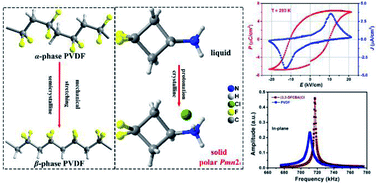A small-molecule organic ferroelectric with piezoelectric voltage coefficient larger than that of lead zirconate titanate and polyvinylidene difluoride†
Abstract
Piezoelectric materials that generate electricity when deforming are ideal for many implantable medical sensing devices. In modern piezoelectric materials, inorganic ceramics and polymers are two important branches, represented by lead zirconate titanate (PZT) and polyvinylidene difluoride (PVDF). However, PVDF is a nondegradable plastic with poor crystallinity and a large coercive field, and PZT suffers from high sintering temperature and toxic heavy element. Here, we successfully design a metal-free small-molecule ferroelectric, 3,3-difluorocyclobutanammonium hydrochloride ((3,3-DFCBA)Cl), which has high piezoelectric voltage coefficients g33 (437.2 × 10−3 V m N−1) and g31 (586.2 × 10−3 V m N−1), a large electrostriction coefficient Q33 (about 4.29 m4 C−2) and low acoustic impedance z0 (2.25 × 106 kg s−1 m−2), significantly outperforming PZT (g33 = 34 × 10−3 V m N−1 and z0 = 2.54 × 107 kg s−1 m−2) and PVDF (g33 = 286.7 × 10−3 V m N−1, g31 = 185.9 × 10−3 V m N−1, Q33 = 1.3 m4 C−2, and z0 = 3.69 × 106 kg s−1 m−2). Such a low acoustic impedance matches that of the body (1.38–1.99 × 106 kg s−1 m−2) reasonably well, making it attractive as next-generation biocompatible piezoelectric devices for health monitoring and “disposable” invasive medical ultrasound imaging.



 Please wait while we load your content...
Please wait while we load your content...